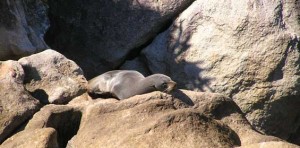
Source: Department of Conservation www.doc.govt.nz – photo by Helen Kettles
Not everyone will want to stay on a boat as they explore the Marine Reserves. In fact, sometimes it is nice to hop off and explore life alongside the creatures that inhabit it. To do this, you often need sandy beaches, relatively calm waters, and beautiful bedrock reefs. There are few better places to get all of these attributes than Tonga Island.
A Marine Reserve for Kayakers and Snorkelers
You can reach Tonga Island via the Totaranui boat ramp, which is five kilometres north of Awaroa Head. Usually, the sea conditions are calm in the winter. However, tidal changes are rapid in the summer, which means you need to make yourself aware of the potential hazards of going kayaking in this area.
Fortunately, for kayakers who love nature, kayaking is one of the best ways to get close to the Tonga inhabitants. At the north of the reserve, you can abandon your kayak and go snorkelling. The seaweed is sparse beneath the veil of the ocean, but to see the wildlife within you really need to dig deep. At first, it seems a little barren, but the more crevices you poke your nose into the more you will see. There is an abundance of crayfish, crabs, blue cod, and if you are lucky, you can feast your eyes on a snapper.
Marine Life Above the Water
Don’t worry if you are not the type to go snorkelling, there is plenty of marine life above the water too. Make your way to Onetahuti Beach to see herons stalking the fish in the small estuary that rests behind it. Lovers of all things cute can gasp at seals from their boat, or explore the rocks and see them up close.
While you are enjoying the animals at Tonga Island, you need to adhere to certain rules:
- You can’t kill any marine life. This means no engaging in activities that could potentially harm them, such as fishing and netting.
- Do not disturb the marine life unnecessarily. If you want to take pictures, do so discretely. No posing with the animals.
- Do not pollute. Picnic by all means, but no littering.
- Don’t remove any natural material from the island. The animals that thrive there rely heavily on their environment. If tourists disturb it, they have little to rely on.
- Don’t remove any plants or animals while on the island itself
- Don’t take your domestic animals with you, such as dogs.
- Only camp in designated areas.
- If you need to light a fire, only do so in the fireplaces provided for you.
Staying on the Island
You can’t stay on every Marine Reserve, so taking up the opportunity to do so when it arrives is always a good idea. You can camp at two areas on Tonga Island. First, there is the Coast Track Awaroa and Bark Bay camping sites. You can book huts and campsite places, which means you don’t need to have perfect tent pitching skills to stay on Tonga.
Then there is Tontaranui, which offers fireplaces, drinking water, and toilets. There is no electricity there, so a stay is the perfect chance to get away from it all.
As one of the easier Marine Reserves to reach, Tonga Island is easy to access and provides accommodation space. Despite a lack of restriction, there are strict rules you must adhere to and paying close attention to them ensures the island retains its natural beauty.
